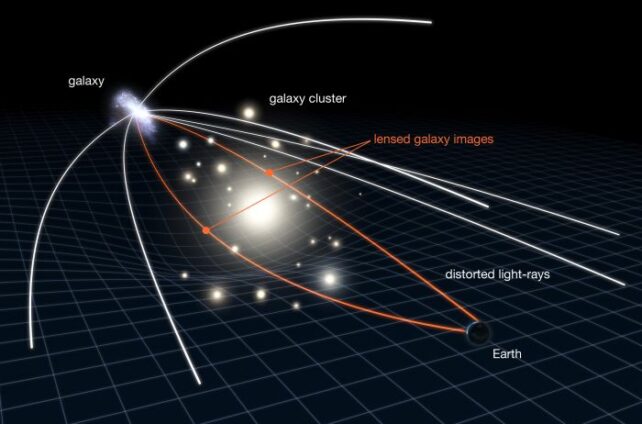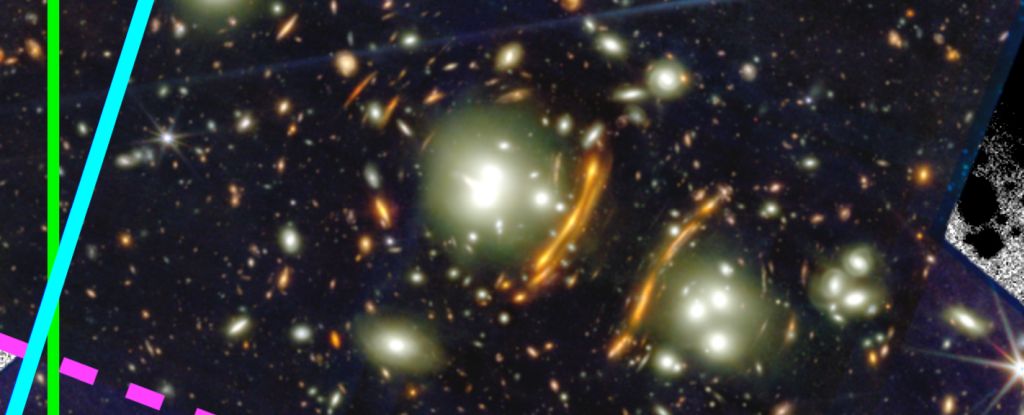A distant supernova whose light has been magnified and triplicated by gravity may be a key to discovering the expansion rate of the Universe.
It’s called SN H0pe, a distorted smudge of light discovered in data collected by the James Webb Space Telescope, from a galaxy whose light has traveled for just over 10 billion years to reach us.
That’s the second-most distant supernova ever observed. And it’s a Type Ia supernova – one whose brightness is used to measure how fast the Universe is expanding.
That alone is not why H0pe is so exciting. The way its light is triplicated by gravity has caused a time delay between images of the supernova – which means it could help scientists solve one of the biggest mysteries in cosmology: how fast the Universe is expanding, a rate known as the Hubble Constant, or H0.
A paper outlining the discovery has been submitted to The Astrophysical Journal, and is currently available on preprint server arXiv.
“We present herein an overview of the initial science results in the combined JWST PEARLS and DDT imaging and spectroscopic observations in the G165 cluster field and of the discovery of the SN, which is dubbed ‘SN H0pe’ for its potential to measure the time delays between the images, and from it, a value for Hubble’s constant,” writes an international team led by cosmologist Brenda Frye of the University of Arizona.
“This study is the first in a series of papers whose objective is to investigate SN H0pe, the cluster, and the lensed sources.”
H0 is an ongoing thorn in the side of cosmology. We know that the Universe is expanding at an accelerating rate; but scientists have been unable to work out what that rate is, beyond a certain range.
There are two main methodologies used to calculate it. The first, known as standard rulers, typically returns an expansion rate of around 67 kilometers per second per megaparsec. The second choice of methods, described as standard candles, gives around 73 kilometers per second per megaparsec.
Standard rulers include the leftover light of the Big Bang in the cosmic microwave background, or acoustic waves frozen in time known as baryon acoustic oscillations.
Standard candles are objects with known intrinsic brightness, such as Type Ia supernovae, or Cepheid variable stars. If you know how intrinsically bright something is, you can calculate how far away it is; and Type Ia supernovae all peak at the same known intrinsic luminosity.
The problem is that beyond a certain light travel distance, small objects like individual stars and even supernovae are very difficult to see, which makes standard candles a poor tool for measuring the expansion rate of the distant Universe. But there’s an exception to this general rule: a gravitational lens.
This is created by a mass significantly hefty enough to induce a significant curvature of space-time. Think of a bowling ball on a trampoline; the bowling bowl is the mass, the trampoline mat is space-time.
Any light traveling through that curved space-time has to travel along a curved path, which can create some interesting effects for any observers on the other side (us). These effects include magnification, distortion, and multiplication of a single light source.

This is how Frye and her colleagues found H0pe. JWST has been taking deep observations of the Universe (and finding lots of interesting gravitationally lensed objects in the process).
Data obtained during multiple observation sessions revealed a galaxy named Arc 2, whose light was lensed by a huge galaxy cluster in the foreground. Those observations revealed three dots of light that analysis revealed were the light of a Type Ia supernova.
Now, scientists have been talking for decades about the possibility of using gravitationally lensed light as a means of measuring the Hubble constant. That’s because, due to the way space-time curves, some of the images may take a longer time to travel through space, meaning that multiplied images can display the light of the source as it appeared at different times.
If the light is from a standard candle, such as a Type Ia supernova, this should be easier to calculate than, say, the light of a galaxy. There’s only been one supernova discovered more distant than H0pe, and it was not lensed; SN Wilson was discovered by observing a galaxy that brightened and dimmed, consistent with a supernova.
We don’t yet have those calculations. This paper is just the first of what looks like many. Future papers will explore in detail the spectroscopy that confirmed the identification of a H0pe as a Type Ia supernova, photometric measurements of the time delay, models of the lens, and other analyses.
“And finally,” the researchers write, “the time delay estimates generated from the lens models, the photometry, the spectroscopy, and the weighted combination of all time delay estimates from these models will be used to measure a value for H0.”
It will be tremendously exciting to find out what that is, and how it fits into the broader context of other measurements of the Hubble constant.
The research has been submitted to The Astrophysical Journal, and is available on arXiv.





